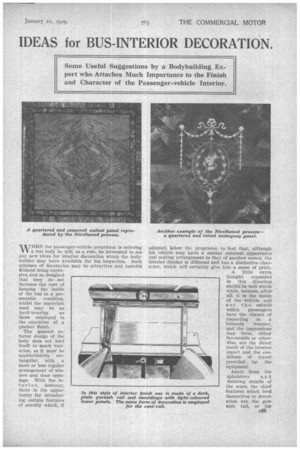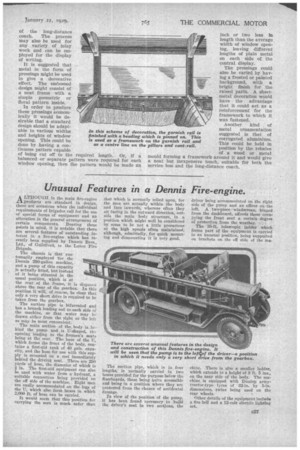IDEAS for BUS-INTERIOR DECORATION.
Page 9

Page 10

Page 11

If you've noticed an error in this article please click here to report it so we can fix it.
Some Useful Suggestions by a Bodybuilding Expert who Attaches Much Importance to the Finish and Character of the Passenger-vehicle Interior.
hard-wearing as those employed in the execution of a plainer finish.
The general exterior design of the body does not lend itself to much variation, as it must be approximately rectangular, with a more or less regular arrangement of window and door openings. With the inter, o r, however, there is the opportunity for introducing certain features of novelty which, if
adopted, llow the proprietor to feel that, although his vehicle may have a similar external appearance and seating arrangement to that of another owner, the interior display is different and has a distinctive character, which will certainly give him a sense of pride.
' A little extra thought expended in this direction should be well worth while, because, after all; it is the inside of the vehicle and not, the outside which passengers have the chance of inspecting in a leisurely manner, and the impressions they form, either favourable or otherWise, are the direct result of the interior aspect and the conditions of travel provided by the equipment.
Apart from the upholstery an finishing details of the seats, the chief features which lend themselves to decoration are the garnish rail, or the member which runs immediately under the windows, the lining boards below, the inside surfaces of the pillars above the waist-line and the cant-rail.
In many service buses no garnish rail is shown, but the lining boards are continued up to the window opening and the top edges of these boards are concealed by a finisher or capping. This is laid On top of the inner waist-rail and usually overhangs an amount equal to its own thickness, and the projecting edge is rounded over.
The lining boards are made of plywood, and if the top ply has a well-defined natural graining these boards help to•make the interior of the vehicle look inviting and give it a Pleasing note. The lining boards, however,cannot be relied upon to form the most effective item in a scheme of interior display, because they are hidden, to a considerable extent, by the seats. The upper part of the lining hoard is. that portion of it which is most easily seen, so that if the garnish rail be exposed and the lining boards fastened under its lower edge, a good portion is then available for ornamentation:
A simple way of enriching the appearance of a plain garnish rail is to finish it .a darker colour than the lining boards, the darker colour also being used for the vertical mouldings which conceal the edges of the plywood panels. The garnish rail may have a mahogany finisher screwed to it, either plain or beaded, which will form a good background for any metal fittings which are disposed along it, such as window winders or match strikers.
The veneering of the garnish rail is now extensively carried out. The veneer may be plain, or the display of graining balanced each side of a centre line, as in the herring-bone c26 pattern, or it may be 'quartered when the -• iguring Of the wood is balanced both horizontally• and Vertically.'
• -• • Inlays of various kinds are used, or a banding' of another veneer may be employed to vary the
design. A. service bus may have an inlaid
garnish rail with the pillars and cant-rail finished with a plain 'capping of the same tone of wood work, but for the more elaborate display in a high-class long-distance coach the .same kind of veneering may be used all around the window . opening.
If a display he the graining of a very choice wood be required, the Nicollwoodprocess is now
available, whereby an expensive veneer can be produced .witn:such fidelity by photographic Means that, unless one were told, it would never he suspected that a veneer had not been glued on in the usual manner.
Nicollwood reproductions can be French7 • polished, or finished in cellulose and, we understand, will bear exposure to the continuous rays o' the sun without losing colour or tone. These repr duetions can be applied to a great variety of ha such as solid wood, plywood, composition board or sheet metals,. either as large or small panels. One of the more recent applications of this process is the reproduction of a lace doyley under a glasstopped table, -making a very effective finish for the folding tables, which are often fixed behind the seats
of the long-distance coach. The process may also be used for any variety of inlay work and can be employed for the display of writing.
It is suggested that metal in the form of pressings might be used to give a decorative effect. The embossed design might consist of a neat frame with a simple geometric or floral pattern inside.
In order to produce these pressings economically it would be desirable that a standard design should be adaptable to various widths and heights of window opening. This could be done by having a continuous pattern capable of being cut off to the required length. Or, if a balanced or separate pattern were required for each window opening, then fhe pattern would be made an inch or two less In length than the average width of window opening, leaving different lengths of plain metal on each side of the central display.
The pressings could also be varied by having a frosted or painted background, with a bright finish for the raised parts. A sheetmetal decoration would have the advantage that it could act as a reinforcement for the framework to which it was fastened.
Another kind of metal ornamentation suggested is that of corrugated aluminium. This could be held in position by the rebates of a wood or metal mould forming a framework around it and would give a neat but inexpensive touch, suitable for both the service bus and the long-distance coach.


































